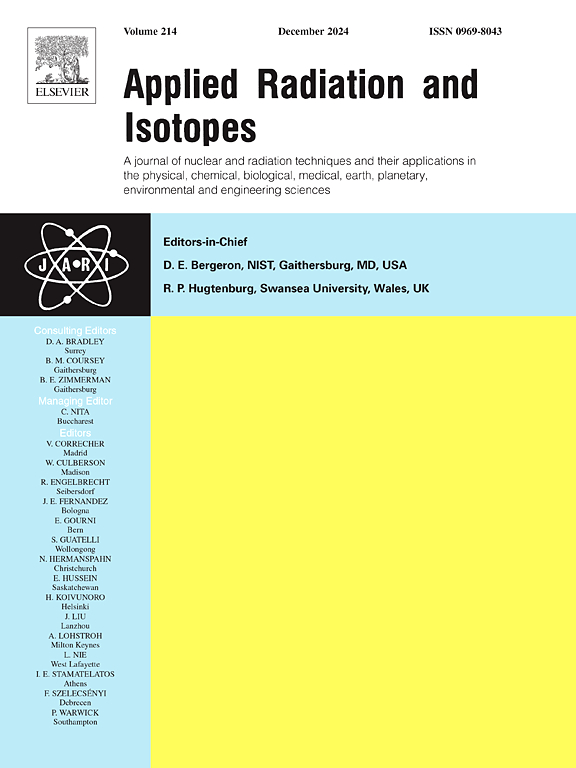Production of 43Sc and 44gSc from natural CaF2 material using an FN Tandem accelerator
IF 1.6
3区 工程技术
Q3 CHEMISTRY, INORGANIC & NUCLEAR
引用次数: 0
Abstract
The radioisotopes of 43Sc and 44Sc are promising in the field of theranostics for their role as β+ emitters in theranostic pairs with 47Sc. Production of these isotopes through various nuclear reactions using either cyclotrons or linear accelerators is of particular interest and previous studies have provided results using accelerated beams of protons, deuterons, and alpha particles. A novel production technique, using an ion source cathode packed with natural calcium fluoride material and irradiated with a 3He beam, was tested at the Nuclear Science Laboratory at the University of Notre Dame in order to initially study the production of 41Ca. Gamma-ray spectrometry revealed presence of 43Sc and 44Sc in the target, and allowed for the first measurement of their yield due to reactions of 3He on natural calcium. The calculated thick target yields of 43Sc and 44gSc from the reactions natCa(3He,x)43Sc and natCa(3He,x)44gSc are compared to theoretical results using TALYS cross section models. Overall, results agree well with models at lower beam energies but tend to diverge at higher energies.
利用 FN 串联加速器从天然 CaF2 材料中生产 43Sc 和 44gSc。
43Sc 和 44Sc 放射性同位素在治疗放射学领域大有可为,因为它们在与 47Sc 的治疗放射学配对中发挥着 β+ 发射器的作用。利用回旋加速器或线性加速器通过各种核反应生产这些同位素特别令人感兴趣,以前的研究已经提供了利用质子、氘核和α粒子加速束的结果。为了初步研究 41Ca 的产生,圣母大学的核科学实验室测试了一种新的生产技术,即使用装有天然氟化钙材料的离子源阴极并用 3He 光束照射。伽马射线光谱仪显示靶中存在 43Sc 和 44Sc,并首次测量了 3He 与天然钙发生反应所产生的 43Sc 和 44Sc 产率。利用 TALYS 截面模型,将计算得出的天然钙(3He,x)43Sc 和天然钙(3He,x)44gSc 反应产生的 43Sc 和 44gSc 的厚靶产率与理论结果进行了比较。总体而言,在较低的束流能量下,结果与模型吻合得很好,但在较高的能量下,结果趋于偏离。
本文章由计算机程序翻译,如有差异,请以英文原文为准。
求助全文
约1分钟内获得全文
求助全文
来源期刊

Applied Radiation and Isotopes
工程技术-核科学技术
CiteScore
3.00
自引率
12.50%
发文量
406
审稿时长
13.5 months
期刊介绍:
Applied Radiation and Isotopes provides a high quality medium for the publication of substantial, original and scientific and technological papers on the development and peaceful application of nuclear, radiation and radionuclide techniques in chemistry, physics, biochemistry, biology, medicine, security, engineering and in the earth, planetary and environmental sciences, all including dosimetry. Nuclear techniques are defined in the broadest sense and both experimental and theoretical papers are welcome. They include the development and use of α- and β-particles, X-rays and γ-rays, neutrons and other nuclear particles and radiations from all sources, including radionuclides, synchrotron sources, cyclotrons and reactors and from the natural environment.
The journal aims to publish papers with significance to an international audience, containing substantial novelty and scientific impact. The Editors reserve the rights to reject, with or without external review, papers that do not meet these criteria.
Papers dealing with radiation processing, i.e., where radiation is used to bring about a biological, chemical or physical change in a material, should be directed to our sister journal Radiation Physics and Chemistry.
 求助内容:
求助内容: 应助结果提醒方式:
应助结果提醒方式:


